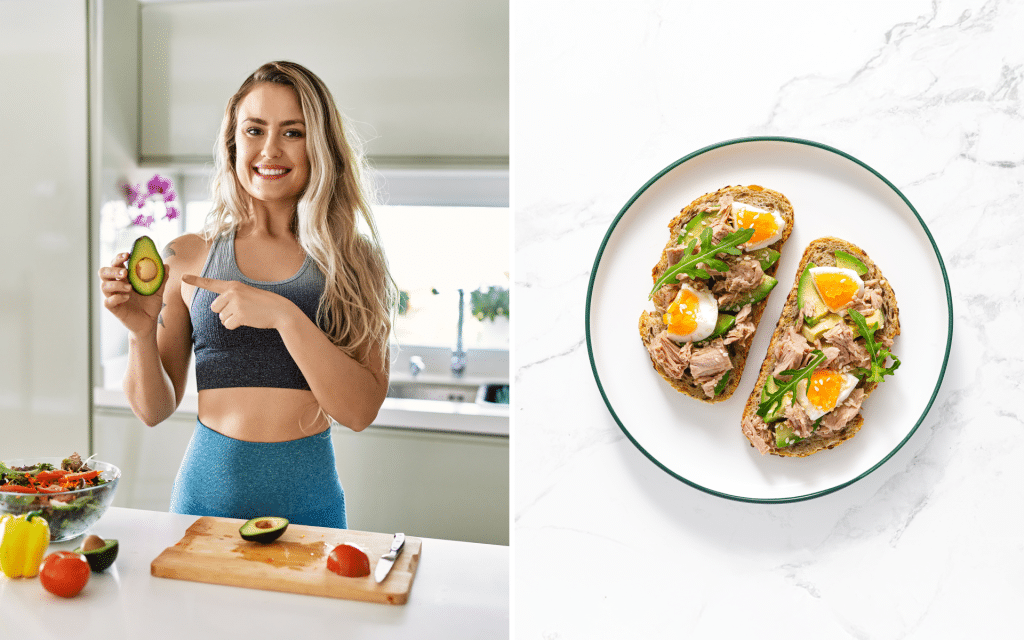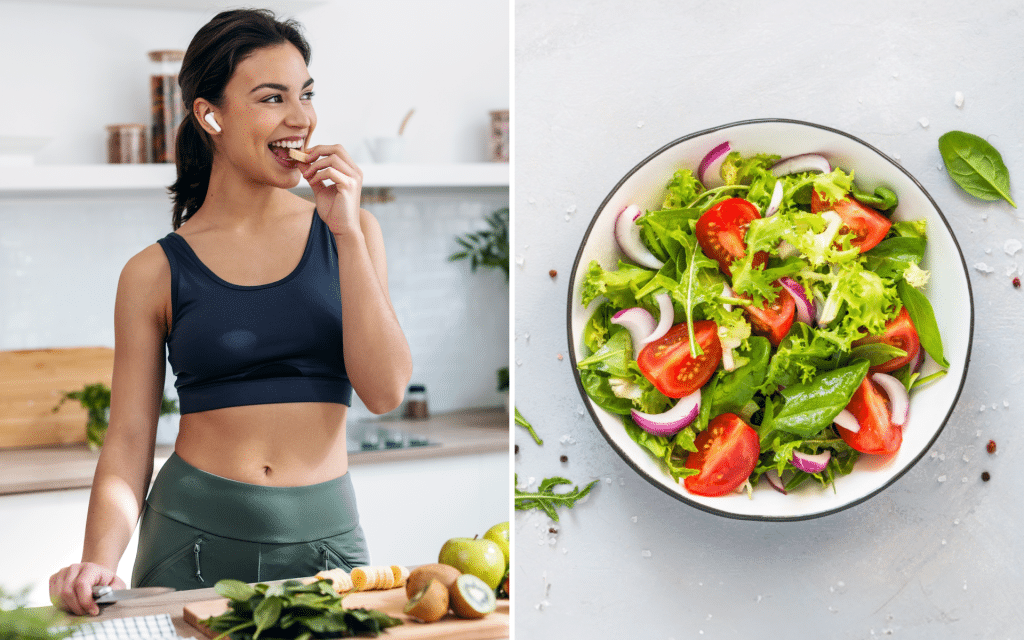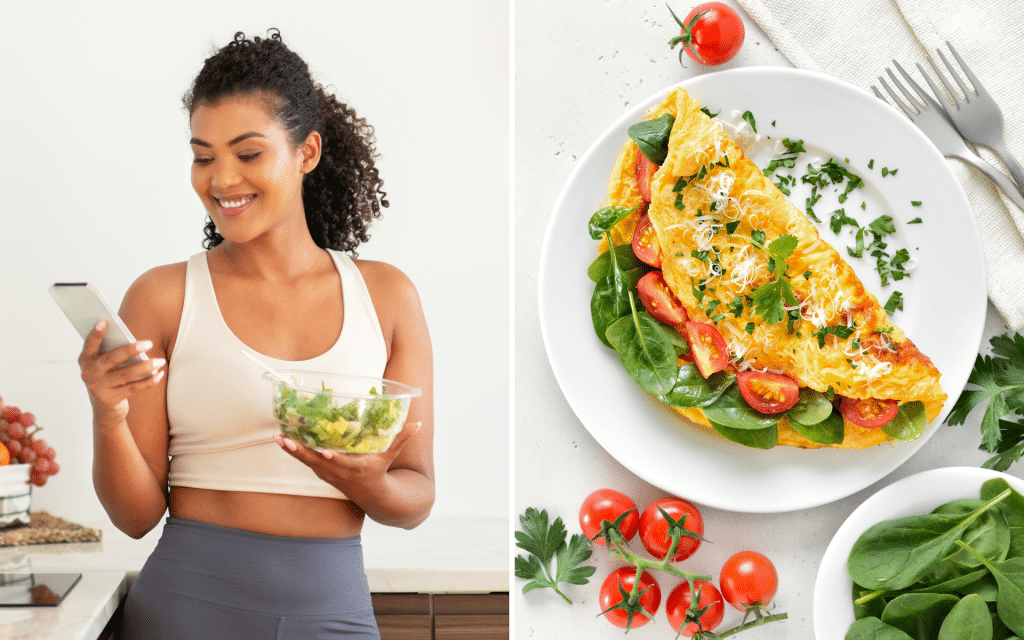A high-protein, low-calorie meal plan can be a powerful tool to help support weight loss, manage your appetite levels, and preserve muscle mass. By focusing on lean protein, while keeping your overall calorie intake in check, you can boost satiety, stabilize blood sugar, and sustain a healthy metabolism, which makes this a wise choice for many health and fitness goals.
What Is a High-Protein, Low-Calorie Meal Plan Good for?
Protein is a vital nutrient for many reasons. It provides the building blocks for body proteins and tissues, including muscle, skin, and enzymes. It’s also one of the most filling nutrients, helping you stay full for longer, reducing cravings and overall calorie intake, and helping with weight management (1).
By maximizing your protein intake and limiting overall calorie intake, you can reap many benefits, such as:
- Protein is a very filling nutrient. Promoting fullness can contribute to a reduced caloric intake and improve weight management. In addition, protein has a higher thermic effect of food (TEF) than fats and carbohydrates, which means the body burns more calories digesting it (2, 3).
- When following a low-calorie meal plan, your body can use either stored fat or muscle as an energy source. By having an adequate protein intake, you help preserve lean muscle mass, which is essential for keeping a healthy metabolism and overall strength (4).
- Protein plays a key role in regulating peptide or protein-based hormones, including those that are involved in weight management and appetite regulation: thyroid hormones, insulin, leptin, and ghrelin. A high-protein diet may help reduce ghrelin levels (also known as the “hunger hormone”) while increasing leptin levels (also known as the “fullness hormone”), which leads to better appetite control and reduced cravings (5).
- As protein can help slow down digestion and nutrient absorption, it can help stabilize blood sugar levels by slowing down glucose absorption. This is a crucial step for proper insulin function, the primary hormone in blood sugar regulation. This could also have an indirect impact on other hormones (6).
- Muscle tissue is more metabolically active than fat tissue, which means that it burns more calories, even when you’re at rest. By preserving lean muscle mass with sufficient protein intake, you’re helping to keep a healthy metabolism, which is essential for long-term weight management (4).
Can You Lose Weight on a High-Protein, Low-Calorie Diet?
Of course you can! A high-protein, low-calorie diet can be an amazing dietary approach to help with your weight loss goals. In fact, this combination can be quite effective and beneficial for your overall health, not solely for weight loss.
For shedding some pounds, the fundamental principle remains the same: you need to create a calorie deficit. This means you have to expend more calories than you consume. Doing so forces your body to tap into stored energy reserves, namely fat, for fuel (7).
However, if you only focus on cutting calories without paying attention to nutrient quality, you could put yourself at risk of muscle loss as well as fat loss. This scenario is detrimental to metabolism and long-term weight management, not to mention overall health and quality of life.
So, here’s where the “high-protein” aspect becomes key. Increasing your protein intake while following a low-calorie diet offers several advantages for weight loss.
Proteins are one of the most filling nutrients, and by promoting fullness, they could help you keep a healthy weight. By eating protein-rich meals, you can feel fuller for longer, naturally reducing hunger pangs and decreasing the chances of overeating or reaching for unhealthy snacks between meals.
BetterMe: Health Coaching app helps you achieve your body goals with ease and efficiency by helping to choose proper meal plans and effective workouts. Start using our app and you will see good results in a short time.
Similarly, your body uses more energy digesting and metabolizing protein compared to other macronutrients. This phenomenon is known as the thermic effect of food (TEF), and this slight increase in calorie expenditure can contribute to the overall deficit (2, 3).
Beyond these two aspects, adequate protein intake, together with strength training, is essential for maintaining lean muscle mass during a calorie-restricted diet. Preserving your lean muscle mass is important as muscle is metabolically active, burning more calories at rest than fat. This helps prevent a slowdown in metabolism, a challenge that is often overlooked during weight loss (8).
When you follow a calorie deficit, your body could turn to either breaking down fat or muscle (or more typically both) for energy. However, by eating enough protein and exercising, you signal your body to retain muscle tissue, ensuring that the main energy source comes from fat stores.
Therefore, a well-planned high-protein, low-calorie diet, paired with regular exercise, particularly strength training to build and preserve muscle, is a powerful approach for sustainable and healthy weight loss while optimizing body composition.
Read more: Is Tofu Vegan: Everything You Need To Know About This Protein-Packed Soya Product
Will I Lose Muscle on a High-Protein Low-Calorie Diet?
If you have a game plan, following a high-protein, low-calorie diet can actually help you maintain muscle. Adequate protein intake helps preserve lean muscle mass and, when paired with resistance training, can also help build more muscle mass.
Evidence has shown that adequate protein while in a calorie deficit significantly helps reduce muscle loss (9, 10).
While individual needs may vary according to age, sex, activity levels, and other factors, a rule of thumb to minimize muscle loss is to:
- Aim for 1.2-1.6 g of protein per kg of body weight per day. For example, a 150-pound woman (approximately 68 kg) should aim for a protein intake of between 82 and 109 grams per day.
- Include resistance training 3-5 times per week. If you’re more on the moderate side, it’s best to aim for the lower range, while if you’re on the very active side, it’s best to aim for the higher range of protein intake.
- Don’t go too low with your calorie deficit. Reducing your overall caloric intake by around 500 calories below your maintenance needs is usually sufficient.
How to Eat Fewer Calories and More Protein
While this may seem like a daunting task, it’s actually much easier than you might think. A rule of thumb to eat fewer calories and more protein is to focus on lean, nutrient-dense protein sources while reducing calorie-dense, low-nutrient foods.
Here are some key strategies to help you achieve this easily:
- Prioritize Lean Proteins
While this may seem obvious, it’s always good to have a friendly reminder. Choosing foods such as chicken breast, turkey, egg whites, Greek yogurt, cottage cheese, tofu, tempeh, lentils, and fish is a fundamental pillar for a high-protein, low-calorie meal plan.
These provide high-quality protein with fewer calories and less fat, which helps you stay full for longer while watching your overall intake.
- Use Protein as the Base of Every Meal
To ensure good protein intake, a simple strategy is to always plan your meals around the protein. For this, start your meal planning with the protein source of choice, and then add vegetables, finishing with complex carbs and healthy fats. This will help you stay full and reduce overall calories.
- Swap out High-Calorie Carbs and Fats
Consider replacing calorie-dense low-fiber options such as white rice or pasta with vegetables (e.g. zucchini noodles, cauliflower rice) or whole grains and go easy on oils, sauces, and dressings. This can be a game changer to keep your calories in check while adding more fiber to your meals to help boost satiety.
- Snack Smart
While snacks aren’t mandatory, if you choose some, it’s important to snack smart. Opt for high-protein, low-calorie options, including hard-boiled eggs, low-fat yogurt, protein shakes with no added sugars, or edamame instead of chips or cookies.
- Choose Low-Calorie Cooking Methods
Grill, bake, steam, or air-fry your food instead of frying. Skip heavy sauces and use herbs, spices, mustard, or vinegar-based dressings for flavor.
- Track Your Intake
Using the Better Me Calorie Tracker can be a great way to help you know where you stand, keeping your protein high and calories in check.
What Food Has the Highest Protein but Lowest Calories?
If you’re aiming to boost your protein intake, there’s no need for expensive supplements or bars. With some planning and a focus on whole, minimally processed foods, you can easily increase your protein levels to support your health and weight goals.
Here are some of the top protein-rich foods you can include in your daily routine:
- Lean meats such as chicken, turkey, and lean cuts of beef are classic for a reason. They offer all nine essential amino acids your body can’t produce on its own.
- Eggs are a compact source of high-quality protein. Don’t skip the yolk – it’s packed with nutrients such as B vitamins, choline, and iron.
- Fish and seafood are excellent additions to your weekly menu. They’re rich in complete proteins and provide healthy fats such as omega-3s, which most meats lack.
- Plant-based proteins aren’t just for vegetarians. Foods such as tofu, tempeh, lentils, chickpeas, and beans offer fiber, vitamins, and minerals, which makes them a smart addition to any balanced diet.
- Dairy proteins such as low-fat Greek yogurt, cottage cheese, and milk are convenient and versatile ways to round out your intake.
- Nuts and seeds provide smaller amounts of protein, but they’re nutrient-dense, offering fiber and healthy fats. A small handful or tablespoon is all you need – opt for unsalted or lightly salted, unsweetened varieties.
Read more: High-Protein Breakfast Without Eggs or Dairy: A Guide to Energizing Mornings
What Are Some High-Protein Low-Calorie Meals?
To help you get started with a high-protein, low-calorie meal plan, here are some great, simple meal ideas you can add to your day-to-day (11):
Breakfast
Egg White and Vegetable Scramble
You’ll need 6 egg whites, ½ cup of spinach, ¼ cup of diced bell peppers, ¼ cup of sliced mushrooms, and 1 teaspoon of olive oil.
This serving offers 122 calories, 13 grams of protein, 7 grams of fat, and only 1.7 grams of carbs.
Greek Yogurt Parfait
You’ll need ¾ cup (170g) of nonfat Greek yogurt, ½ cup of mixed berries, and 1 tablespoon of chia seeds.
This serving offers 230 calories, 13 grams of protein, 39 grams of carbs, and only 4.5 grams of fat.
Protein Oats with Peanut Butter and Banana
You’ll need ½ cup (40g) of rolled oats, 1 scoop (30g) of vanilla whey protein powder, 1 teaspoon of natural peanut butter, ½ sliced small banana, and ¾ cup of low-fat milk.
This serving offers 305 calories, 25 grams of protein, 29 grams of carbs, and only 9 grams of fat.
The BetterMe: Health Coaching app will provide you with a host of fat-frying fitness routines that’ll scare the extra pounds away and turn your body into a masterpiece! Get your life moving in the right direction with BetterMe!
Lunch/Dinner
Grilled Chicken Salad
You’ll need 120 grams of grilled chicken breast, 2 cups of mixed greens, ½ cup of cherry tomatoes, ¼ cup of sliced cucumber, and 2 tablespoons of Italian dressing (or homemade dressing)
This serving offers 302 calories, 30 grams of protein, 17 grams of fat, and only 9 grams of carbs.
Baked Cod with Steamed Broccoli
You’ll need 150 grams of baked cod, 1 cup of steamed broccoli, 1 teaspoon of olive oil, lemon juice, and herbs to taste.
This serving offers 297 calories, 32 grams of protein, 16 grams of fat, and only 7 grams of carbs.
Turkey Lettuce Wraps
You’ll need 100 grams of cooked lean ground turkey, 2 large romaine lettuce leaves, ¼ cup of diced onions, ¼ cup of diced bell peppers, and 1 teaspoon of olive oil.
This serving offers 327 calories, 27 grams of protein, 18 grams of fat, and 17 grams of carbs.
Snacks
Turkey and Cucumber Roll-Ups
You’ll need 3 slices of deli turkey breast (84g), ½ medium cucumber, sliced into strips, and 1 teaspoon of hummus.
This serving offers 120 calories, 18 grams of protein, 5 grams of fat, and only 3 grams of carbs.
Apple Slices with Greek Yogurt Dip
You’ll need ½ medium apple (75g), sliced, ¼ cup nonfat Greek yogurt (60g), mixed with cinnamon.
This serving offers 110 calories, 10 grams of protein, 15 grams of carbs, and zero fats.
Egg and Avocado Rice Cake
You’ll need 1 hard-boiled egg, sliced, 1 thin rice cake, and 1 tablespoon mashed avocado.
This serving offers 160 calories, 9 grams of protein, 13 grams of fat, and 9 grams of carbs.
There’s no single answer here – it depends on your goals and overall needs. Following a high-protein diet can help control hunger levels and support muscle growth when paired with regular exercise. This alone could naturally lead to overall reduced calorie intake. However, if your goal is weight loss or gain, tracking your caloric intake could be a good strategy, if you find it helpful. Egg whites and white fish such as cod are at the top of the list. In addition to protein, they have very little amounts of fat or carbs, which makes them the best and highest protein-to-calorie ratio to add to your daily meals. No. As a rule of thumb, for most healthy adults, eating 100 grams of protein daily is an ideal amount, and it’s usually safe, particularly if you’re very active and don’t have any underlying kidney issues. However, individual needs vary based on weight, activity level, and health goals. Consulting a registered dietitian to assess your personal needs is always a good idea. Chicken breast is generally considered the winner when it comes to the “king of protein” award. It’s an incredibly lean and relatively affordable meat, offering approximately 30 grams of high-quality protein per 100 grams. In addition, it has very few carbs or fat. This makes chicken breast an ideal high-protein food for muscle building, weight management, and overall nutrition.Frequently Asked Questions
Do you need to count calories on a high-protein diet?
What food has the highest protein-to-calorie ratio?
Is 100 grams of protein in one day too much?
Which food is the king of protein?
The Bottom Line
A balanced high-protein, low-calorie meal plan is about more than just increasing protein and cutting back on calories – it’s about integrating it into a nutrient-rich diet including fiber, healthy fats, and essential vitamins and minerals.
Protein helps with satiety, muscle preservation, and hormone regulation, supporting healthy weight loss. Regardless, it’s essential not to cut calories too drastically, as overly restrictive diets can lead to nutrient deficiencies and muscle loss, which is the opposite of what you want.
A moderate calorie deficit combined with 1.2 to 1.6 grams of protein per kg of body weight is typically effective and sustainable. However, individual needs may vary. The information shared in this article is for informational purposes only and consulting a registered dietitian can help you determine what’s the optimal protein intake for your needs.
DISCLAIMER:
This article is intended for general informational purposes only and does not serve to address individual circumstances. It is not a substitute for professional advice or help and should not be relied on for making any kind of decision-making. Any action taken as a direct or indirect result of the information in this article is entirely at your own risk and is your sole responsibility.
BetterMe, its content staff, and its medical advisors accept no responsibility for inaccuracies, errors, misstatements, inconsistencies, or omissions and specifically disclaim any liability, loss or risk, personal, professional or otherwise, which may be incurred as a consequence, directly or indirectly, of the use and/or application of any content.
You should always seek the advice of your physician or other qualified health provider with any questions you may have regarding a medical condition or your specific situation. Never disregard professional medical advice or delay seeking it because of BetterMe content. If you suspect or think you may have a medical emergency, call your doctor.
SOURCES:
- The role of protein in weight loss and maintenance (2015, sciencedirect.com)
- Clinical Evidence and Mechanisms of High-Protein Diet-Induced Weight Loss (2020, pmc.ncbi.nlm.nih.gov)
- The Thermic Effect of Food: A Review (2019, pmc.ncbi.nlm.nih.gov)
- Dietary Protein and Energy Balance in Relation to Obesity and Co-morbidities (2018, pmc.ncbi.nlm.nih.gov)
- Biochemistry, Peptide (n.d., ncbi.nlm.nih.gov)
- Physiology, Glucose Metabolism (n.d., ncbi.nlm.nih.gov)
- Calorie Deficit: What To Know (n.d., health.clevelandclinic.org)
- Weight Loss Strategies and the Risk of Skeletal Muscle Mass Loss (2021, pmc.ncbi.nlm.nih.gov)
- A systematic review, meta-analysis, and meta-regression of the effect of protein supplementation on resistance training-induced gains in muscle mass and strength in healthy adults (2017, pmc.ncbi.nlm.nih.gov)
- Protein supplementation augments the adaptive response of skeletal muscle to resistance-type exercise training: a meta-analysis (2012, sciencedirect.com)
- Eat this much (n.d., eatthismuch.com)












